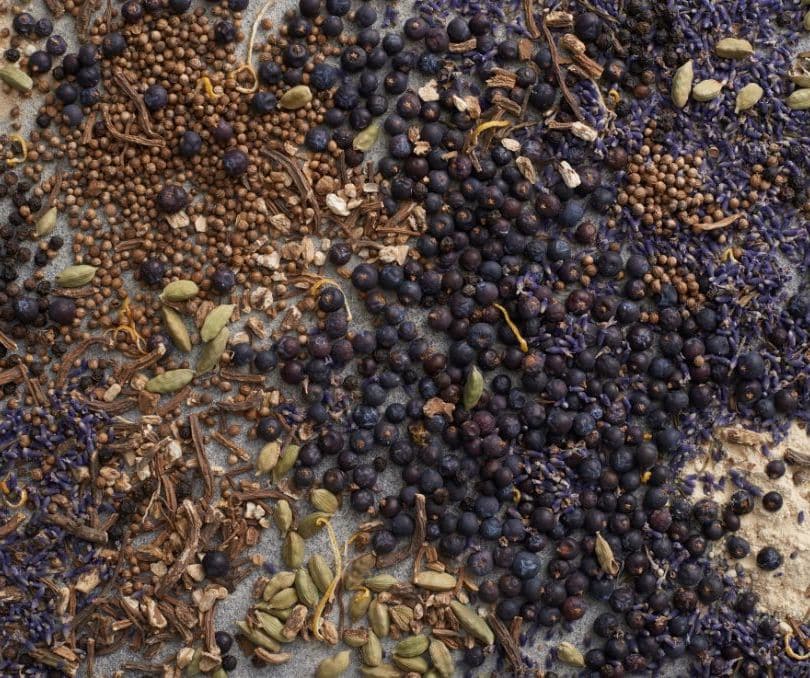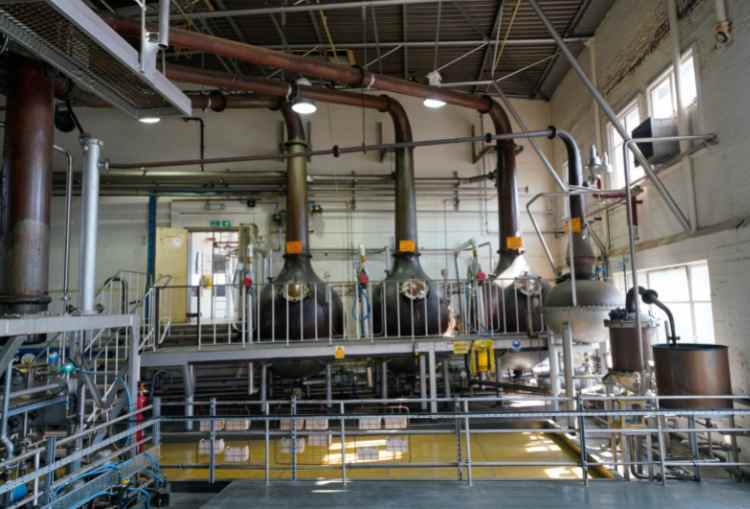Gin is a very special kind of spirit characterized by its distinct juniper note. Every Gin maker seems to have a unique combination of botanicals, processes, and base spirit. Some use only a handful of botanicals, while others include more than forty in their gin.
We have put together an exhaustive guide on gin production: here's all about the base ingredients, the processes master distillers follow to make gin, and the different distillation methods.

Base ingredients for making gin
In a nutshell, gin is a spirit that contains at least 37.5% (in the EU) or 40% (in the US) of alcohol, flavored with juniper berries and other botanicals like angelica root and coriander seeds. This short definition already implies the ingredients used, which are:
- Base spirit: A neutral spirit made from agricultural products like grains, fruits, or vegetables. For distilled gin, the base alcohol needs to contain 96% vol. alcohol but can be reduced with water.
- Water: Typically, fresh spring water is used to balance the alcohol levels and achieve the desired ABV.
- Juniper berries: After distillation, juniper often develops a slightly woody and piney flavor.
- A set of additional botanicals: Botanicals bring flavor to the gin. The dominant savor has to be juniper. Apart from that, there are no further regulations. Check our guide to the most popular botanicals in gin for a better overview of the common ingredients.
The Different Distillation Methods to Make Gin
There are multiple ways and methods to bring botanical flavors into gin. -And not only different distillation methods, but also entirely different procedures to infuse flavors. The options are:
- Maceration & distillation
- Vapor infusion
- Vacuum distillation
- Cold-compounding
- Others and combinations
Here's a short explanation for each of these techniques to give you a better understanding:

1. Maceration & distillation
In this classic method of making gin, the juniper berries and other botanicals are macerated in a base spirit anywhere from just a few hours up to two days.
Some gin makers, like Tanqueray, skip this steeping process altogether and distill the spirit right after adding the botanicals. Then, once the master distiller declares the mix to be ready, the base spirit is distilled along with the botanicals.
This way of making gin is used by many traditional brands, two of the most popular ones being Beefeater and Tanqueray. However, Beefeater steeps their botanicals for 24 hours before distillation, unlike Tanqueray.
2. Vapor infusion
This method skips maceration, so the botanicals never come in contact with the spirit in liquid form. Instead, the botanicals are combined in baskets and put inside modified stills.
As the spirit evaporates during the gin distillation process, it's vapor-infused with botanicals when passing these baskets. After that, the vapor is condensed back into a botanical-flavored spirit.
One of the most popular gin brands applying this technique is Bombay Sapphire. It often leads to a fresher and lighter product, and Bombay themselves claim that it results in a more delicate Gin when compared to other classic London Drys.
3. Vacuum distillation
This method is also called cold gin distillation. It's similar to the classic maceration and distillation process but uses a vacuum. That reduces the boiling point for ethanol and allows a colder distillation process.
The higher the vacuum, the lower the temperatures needed for boiling the base spirit. Master distillers claim that this method also brings fresher flavors into gin. The classic method cooks the botanicals at too-high temperatures, stewing and boiling them.
To put this into perspective, the natural boiling point of ethanol is 78°C or 172°F. In a vacuum, it can be reduced to 34°C or 93°F.
4. Cold-compounded gin
A simpler way to make gin is by adding botanicals to a base spirit let it sit for 24 to 48 hours. It will get infused with the botanical flavors but will also take on the color and thus become a brownish-yellowish color.
After that period, the botanicals are filtered out and the gin gets bottled. This technique is called cold-compounding and is only used for one type of gin called Bathtub.
Today, this method is rarely used to produce gin because it's regarded as inferior to other methods. However, it's the easiest way to make your own gin at home.
5. Others and combinations
There are many variations within these distillation methods. Some gin producers even combine two or more techniques to create their final product.
Often, they merge the classic maceration approach with vapor infusion for a more balanced gin boasting a more complex flavor profile.
Some brands macerate and distill each botanical separately and then blend the different distillates. The supposed advantage of this process is that you can better control how individual botanicals interact. However, critics point out that with this approach, the blending of the botanicals is lost and creates a disjointed gin.
How Gin is Made - A Step-by-Step Guide
Gin production is a complex process that requires several steps until the final product is ready to be bottled. Here's an overview:
1. Making the base spirit
Most gin producers use a spirit from a third-party distiller. Some produce their base spirit from scratch. In any case, the ingredients used to make the base spirit must be of agricultural origins, like grains, potatoes, or grapes.
These are the steps for making the base spirit:
- These agricultural products are combined with water and yeast and then heated and stirred until they turn into a well-combined mix called "mash" or "gin mash".
- The mixture is left to ferment. This process typically takes between 10 to 14 days. During this time, the components will deconstruct and create ethanol resulting in a low-ABV liquid.
- After fermentation, the remaining solids are filtered out, and the liquid is distilled into the base spirit.
2. Botanical infusion and 2nd distillation
Now that we have a base spirit, it's time for botanicals. The traditional way to make gin is the two-step process of macerating or steeping botanicals and following distillation. Here are the main ones again for easy reference:
- Maceration & distillation
- Vapor infusion
- Vacuum distillation
3. The result of the distillation process
As for other spirits, the final result of distilling gin is typically divided into three categories: the heads, the heart, and the tails. Only the heart will go into the final gin. Heads and tails are discarded or added to the next batch for re-distillation.
During the distillation process, the alcohol content of the final product gets lower and lower. That is because the concentration of ethanol in the base spirit is the highest in the beginning and drops subsequently.
Here's a quick definition of the three components of a Gin distillate:
- Heads: As the name already suggests, the head of distillate is the first part of the liquid produced and amounts to about 2% to 18% of the batch. "Heads" are very high in alcohol, typically over 80% ABV, and have a distinct and unpleasant smell of methanol.
- Heart: When the amount of alcohol drops below 80%, the "heart" of a distillate is cut. The heart is not only the premium product that is later bottled, but it's also the largest portion of distillate and accounts for 55% to 70% of the final product. As long as the distillate is over 50%, it belongs to the heart.
- Tails: When the alcohol content drops below 50%, the second cut occurs, separating the heart from the tails. When the ABV drops below this point, the still is usually stopped. A distillate usually contains more tails than heads. In numbers, this means somewhere between 15% to 25% of the final product. The smell is not ideal neither is the consistency. "Tails" are often oily and greasy, thus, typically discarded.
4. Watering down & bottling
The heart of the distillate is typically way above the final bottle strength. To bring it to the desired ABV, distillers mix it with water. Most gin makers will dilute their gin to either 37.5% or 40% ABV since these are the minimum requirements by law in the EU and USA.
Once the gin reaches the desired alcohol content, it's ready for bottling and labeling.
Differences depending on styles
There are many differences in gin production, often depending on the style of gin. A London Dry Gin has to fulfill significantly more legal requirements than an ordinary gin. An Aged Gin has to rest in barrels before bottling, and Bathtub Gin doesn't require distillation at all. To get a better understanding of these types, check out our complete guide to different gin styles and their characteristics.

